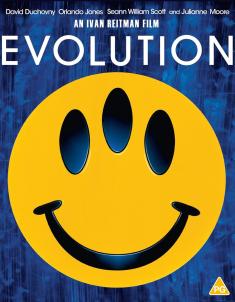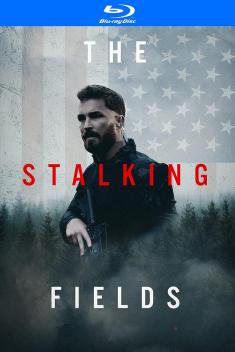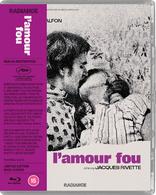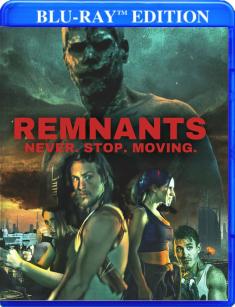In a Lonely Place - Criterion Collection
Overview -
When a gifted but washed-up screenwriter with a hair-trigger temper—Humphrey Bogart, in a revelatory, vulnerable performance—becomes the prime suspect in a brutal Tinseltown murder, the only person who can supply an alibi for him is a seductive neighbor (Gloria Grahame) with her own troubled past. The emotionally charged In a Lonely Place, freely adapted from a Dorothy B. Hughes thriller, is a brilliant, turbulent mix of suspenseful noir and devastating melodrama, fueled by powerhouse performances. An uncompromising tale of two people desperate to love yet struggling with their demons and each other, this is one of the greatest films of the 1950s, and a benchmark in the career of the classic Hollywood auteur Nicholas Ray.
Storyline: Our Reviewer's Take
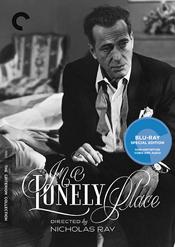
"I was born when she kissed me. I died when she left me. I lived a few weeks while she loved me."
Few filmmakers have explored the insecurities, tortured psyches, and repressed emotions of average Americans better than Nicholas Ray. Though his film canon is relatively small, this independent-minded, often underrated director who flourished for far too brief a period during the 1950s captures with astonishing acuity the essence of the human condition. 'They Live by Night,' 'Johnny Guitar,' 'Rebel Without a Cause,' and 'Bigger Than Life' all profile people with deep psychological scars who fight tooth and nail for some small measure of acceptance and peace. The same can be said of 'In a Lonely Place,' a fascinating, brilliantly constructed and executed slow-burn thriller that not only gets underneath its characters skins, but also the environment in which they exist ("live" is too strong a word).
That environment is Hollywood, and though 'Sunset Boulevard,' released the same year, grabbed all the critics' laurels and is largely remembered as the film that dared to expose Tinseltown's tawdriness, 'In a Lonely Place' (the title alone screams damaged goods) explores the industry's desolation and emptiness with rare candor and poetic grace. Exquisitely adapted by Andrew Solt from a smoldering crime novel by Dorothy B. Hughes (which it only loosely follows), this subtle, savvy, and incisive movie has always been classified as a film noir, but it's really a riveting character portrait of two lost souls who briefly unite and allow insidious influences and inner turmoil to tear them apart. Humphrey Bogart and Gloria Grahame, in performances that rank among the best of their respective careers, bring these troubled drifters to life with keen insight and a heartbreaking sensitivity. Hard knocks and disillusionment put both characters on their guard, but once their tough shells are cracked, what Ray reveals is raw and real.
Loneliness seems inconceivable in a social mecca like Hollywood, but for outsiders who don't, won't, or can't play the game, it can be a very forsaken place indeed. Cynical screenwriter Dixon Steele (Bogart) knows this all too well. Once the toast of the town, he hasn't had a hit in years, and his gruff, mercurial personality, peppered with unpredictable conniptions, has alienated all but a handful of friends. Dix wants to work, but refuses to cowtow to a system he loathes or waste energy on material he believes is beneath his talent. And yet, of course, he needs money. At a bar one night, his agent convinces him to consider writing a script based on a sudsy potboiler. He can't bear to read the book, so when he hears the comely hatcheck girl, Mildred Atkinson (Martha Stewart - no, not that Martha Stewart), is a big fan, he suggests she come home with him and tell him the story. Whether the invitation is a straightforward business proposition or a pick-up attempt isn't totally clear, but Mildred agrees and goes to Dix's apartment.
Her enthusiasm for the material, however, is not contagious, and a bored Dix tunes out her ceaseless chatter, preferring instead to catch isolated glances of a mysterious blonde woman who lives across the courtyard. Her name is Laurel Gray (Grahame), a jaded, down-on-her-luck actress who's also fed up with the system and has begun to retreat inward. Once Mildred wraps up her synopsis, Dix ushers her out, giving her bus fare so she can make it back home, but the next morning, Brub Nicolai (Frank Lovejoy), an old army buddy who's also a police detective, shows up at Dix's door and informs him Mildred was found dead at the bottom of a canyon. Brub brings Dix down to the station for questioning, and his flippant responses and past record of violent outbursts make him an instant suspect. Yet while he's there, Laurel gives a statement, too, fabricating a necessary alibi for Dix. "I like his face," she tells the cops. The two soon begin a tentative relationship that blossoms into love, but as the investigation proceeds, Laurel learns of Dix's violent history, and when she witnesses his rages firsthand, she begins to fear him, and seeds of doubt about his innocence gnaw at her conscience.
I recently reviewed Alfred Hitchcock's 'Suspicion,' which traverses similar territory, but in a romantic, dreamy context that lacks bite. While watching 'In a Lonely Place,' I kept thinking "this is the film Hitchcock should have made." Ray nails the concept, upping the ante by adopting a more realistic, relatable tone and adding welcome grit, introspection, and a splash of devastating irony. Unlike most film noirs, the violence often simmers beneath the surface. We know it will boil over, but when, how, and in what manner forms the tension. Dix is a hothead, but even he can't understand why he reacts the way he does and what triggers his frightening outbursts. The war is vaguely cited as a contributing factor, and Dix's symptoms generally resemble those associated with post-traumatic stress, although it would be decades before the syndrome would be so labeled.
That's just one example of how Ray's film is ahead of its time. Another is the adult depiction of the relationship between Dix and Laurel. Both seek something real in a land of illusion and artificiality, and both are cautious, often wondering if this is their last chance at a happily-ever-after. The aura of dread that usually swirls around a noir murder or heist instead swirls around their relationship, which is the film's ticking time bomb. Sure, some clever noir quips lace the dialogue, but most of the talk is natural, sincere, and disarmingly blunt. There's a moment when Laurel whispers something into Dix's ear that's so breathtakingly intimate, for a second we forget we're watching a movie and feel as if we're eavesdropping on a private exchange.
We also may be watching the end of the Ray-Grahame marriage. The couple wed hastily after Grahame became pregnant in the late 1940s, and only a couple of years later their tempestuous union finally imploded during the production of 'In a Lonely Place.' They kept their separation a secret from the cast and crew to maintain harmony during shooting. Ray lived on the set, claiming he needed to work on the script, while Grahame would go home at night to care for their son. No one knew what was transpiring behind the scenes, but many believe the issues Dix and Laurel face and the friction between them somewhat mirrored the fissures in the Ray-Grahame marriage. (After numerous break-ups and reconciliations, the couple finally divorced in 1952 after Ray discovered Grahame in bed with his 13-year-old son. No, that's not a typo.)
Bogart fully inhabits this character and files one of his most natural and convincing portrayals. Away from the constraints and typecasting of Warner Bros ('In a Lonely Place' was an independent film produced by Bogart's own fledgling company and released by Columbia), he spreads his wings, exploring different facets of his well-oiled persona. Older, more weathered, and a bit beaten down, he projects a vulnerability and edginess that's fresh and exciting. His wife, Lauren Bacall, would have made an excellent Laurel (you can almost hear her smoky voice reciting some of the dialogue) and Bogart wanted her, but when Jack Warner refused to loan her out, Ray went with Grahame, and now it's almost impossible to imagine anyone else playing the part.
Grahame's initial coolness gives way first to a winning warmth and then an intense apprehension that drives the film to its devastating conclusion. (One wonders whether Bacall possessed the proper range to sufficiently tackle the role.) Rarely more beautifully photographed, Grahame is always fascinating to watch, and this breakout portrayal paved the way for memorable performances in 'The Bad and the Beautiful' (for which she won a Best Supporting Actress Oscar), 'The Greatest Show on Earth,' 'The Big Heat,' and 'Oklahoma!'. A terrific supporting cast also enhances the film, as does the superb noir photography of Burnett Guffey ('From Here to Eternity,' 'Bird Man of Alcatraz,' 'Bonnie and Clyde').
In addition to the suspenseful story, intriguing characters, and potent themes, a tragic elegance swirls about 'In a Lonely Place.' Though the script's original ending would have wielded plenty of power, Ray disliked its neat and tidy packaging and changed it on a whim, injecting a haunting ambiguity that's rare in the black-and-white world of film noir. That fateful decision makes the movie difficult to forget and helps cement its status as one of Ray's finest and most affecting productions.

The Blu-ray: Vital Disc Stats
'In a Lonely Place' arrives on Blu-ray packaged in a standard Criterion case. A 12-page fold-out booklet featuring an essay by Imogen Sara Smith, cast and crew listing, transfer notes, and a large photo of Bogart and Grahame is tucked inside the front cover. Video codec is 1080p/AVC MPEG-4 and audio is LPCM mono. Once the disc is inserted into the player, the static menu with music immediately pops up; no previews or promos precede it.
Video Review

Once again, Criterion delivers a stunning black-and-white transfer of a classic Hollywood film. Recently remastered in 2K, this crisp, deliciously lush rendering was struck "from a new 35 mm fine grain master positive made from the original camera negative." Grain is still evident, but is seamlessly integrated into the film's fabric, and superior contrast and clarity make the image pop. Blacks are inky and rich, whites are well defined, and the grays in between flaunt enough variance to highlight plenty of fine details. Close-ups are razor sharp, beautifully highlighting Grahame's alabaster complexion and Bogart's swarthy ruggedness, while strong shadow delineation maximizes the impact of all the noir touches. Only a few stray marks dot the otherwise pristine source material, and no noise or crush disrupt the silky smooth presentation. When done right, black-and-white transfers can best their color counterparts, and this effort from Criterion would be a formidable foe in any such competition.
Audio Review

According to the liner notes, the LPCM mono track was "remastered at 24 bit from the original 35 mm soundtrack negative," and the results are quite impressive. Full-bodied and well modulated, the audio complements the action without overwhelming it. George Anthiel's lush score sounds especially good, thanks to excellent fidelity and tonal depth, and all the dialogue is clear and easy to comprehend. Best of all, no age-related imperfections, such as hiss, pops, or crackles, intrude, and no distortion creeps into the mix. Even during moments of high tension, the track remains rock solid, while quiet moments maintain the intimacy that's such a vital component of the drama.
Special Features

As usual, Criterion compiles a comprehensive collection of supplements that provides essential context and perspective on this classic film.
-
Audio Commentary - NYU professor Dana Polan provides an informative and largely analytical commentary that's chock full of interesting nuggets. He believes 'In a Lonely Place' is just as much a woman's picture as it is a film noir, and he talks at length about the hidden and unclear motives that drive both genders during the course of this "anti-establishment" movie. Polan praises director Nicholas Ray for examining the nature of masculinity and explicitly addressing the prevalence of violence against women in our society. He also outlines the differences between the film and source novel, describes an alternate ending, notes how Bogart's personal life somewhat mirrors that of his character, and shares some choice morsels about the troubled marriage between Ray and Gloria Grahame. Polan spends a bit too much time analyzing the film's plot and doesn't provide any biographical information about the cast and crew, but his thoughtful remarks about the changing face of Hollywood, film technique, and American society keep this commentary stimulating from beginning to end.
-
Documentary: "I'm a Stranger Here Myself" (HD, 41 minutes) - This bizarre, introspective profile of a broken-down Ray, completed just four years before his death, captures the director while he was teaching at SUNY Binghamton and shooting 'We Can't Go Home Again,' an experimental project on which he collaborated with his students. Wearing an eye patch and looking far older than his 64 years, Ray reflects on directing and shares an interesting anecdote about 'In a Lonely Place.' Some brief biographical information is included, as well as interviews with John Houseman (whom Ray identifies as one of his two key mentors), François Truffaut (who praises 'Johnny Guitar' and talks about the profound influence it had upon him), and Natalie Wood (who recalls how she got her role in 'Rebel Without a Cause' and discusses Ray's relationship with co-star James Dean). Shot in black-and-white and exuding a gritty, low-budget feel, 'I'm a Stranger Here Myself' often seems disjointed and unfocused, but it does paint an intimate portrait of Ray and allows him the opportunity to talk freely about his profession. I would have preferred a more straightforward documentary featuring more film clips and interviews with colleagues, but this "unplugged" look at the director is also fascinating and very, very sad.
-
Featurette: "Bad and Beautiful: Gloria Grahame" (HD, 17 minutes) - Grahame biographer Vincent Curcio discusses the Oscar-winning actress, zeroing in on her commitment to her craft, eccentricities, and tempestuous marriage to Nicholas Ray. He talks about her spontaneous acting style, the importance of 'In a Lonely Place,' and how she used plastic surgery to help refine the characters she portrayed. He also examines how 'In a Lonely Place' largely reflects the doomed Ray-Grahame marriage. Several clips from 'In a Lonely Place' (sadly, none of Grahame's other movies are represented) and a number of rare production photos enhance this brief but enlightening profile.
-
Featurette: "'In a Lonely Place' Revisited" (HD, 20 minutes) - Director Curtis Hanson hosts this personal tribute to 'In a Lonely Place' (produced in 2002), which he calls "one of the best movies ever made about Hollywood." Hanson recalls the film's "hypnotic power" and how it influenced him, and talks about the title's significance, how the role of Dix Steele captures Bogart's essence, and how the intimate collaboration between Bogart and Ray produced a rich, full-bodied film. Hanson's high regard for the movie is quite evident, and his reverent remarks are both informative and eloquent.
-
Vintage Radio Adaptation (60 minutes) - On March 6, 1948, two years before the release of the film version of 'In a Lonely Place,' actor Robert Montgomery starred in a radio adaptation of the Dorothy B. Hughes novel for the weekly CBS series, 'Suspense.' Featuring poetic prose, plenty of atmosphere, and a terrific performance by Montgomery as Dix, this absorbing, highly entertaining adaptation follows the book more closely than the film. Here, Dix is an unabashed and unapologetic serial killer, and the bulk of the story chronicles his exploits, cover-ups, and the ongoing police investigation Into his crimes. The Dix-Laurel romance is only a minor subplot, as the focus remains squarely on the psychotic mind of a murderer. Overly melodramatic music occasionally cheapens the program, but the excellent script and portrayals make this tense drama a great companion piece to the movie and well worth a listen.
-
Theatrical Trailer (HD, 2 minutes) - The film's original preview (which, by the way, looks great) touts 'In a Lonely Place' as "the suspense picture of the year!" and includes a line uttered by Grahame during the climax that was cut prior to the picture's release.
Final Thoughts

An atypical film noir that focuses on underlying emotion and repressed angst more than overt action and violence, 'In a Lonely Place' stands as one of director Nicholas Ray's finest achievements. Few movies of any era explore desolation, need, and fear with such acuity and intensity, or paint a more cynical picture of Golden Age Hollywood. As a couple of lost, disillusioned souls who long to connect but can't overcome their personal frailties, Humphrey Bogart and Gloria Grahame both file portrayals that rank among the best of their respective careers, and their potent chemistry drives this understated film to great heights. Criterion's Blu-ray presentation scores big across all categories, with top-notch transfers and supplements enhancing the viewing experience and helping this devastating drama earn a high and hearty recommendation.






